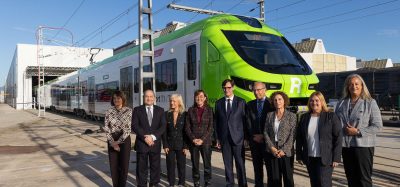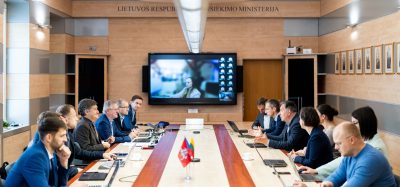Rail communication testing for FRMCS: a light at the end of the tunnel
Posted: 16 September 2025 | Massimiliano Beccuti | No comments yet
Massimiliano Beccuti, Product Line Director for Railway at VIAVI, discusses FP-MORANE-2, the pilot programme for rail’s much needed switch to FRMCS.


Upgrading rail communication to FRMCS will enable the digitalisation of rail services.
Around the world, there is a push to reduce dependence on the car by investing in infrastructure to encourage greater use of public transport. Some recent examples come to mind: New York’s congestion charging, the Netherland’s cycling infrastructure in Utrecht, Paris’s zonal bans, reduction of parking spaces and added bike lanes (as seen in the 2024 Olympics), and Seoul’s (Rep of Korea) conversion of an inner-city highway used by 168,000 people per day into a stream.
New York is already seeing fewer cars and faster commutes. Paris has seen pollution half. The shift is not solely for noise / air pollution reasons (albeit this is significant), but economic ones too, with the upkeep of the aging infrastructure being more expensive than local taxation revenues permit. For example, in Lafayette, LA, it has been calculated that to maintain just the roads and drainage already built, median taxes will need to more than triple.
With transport needing to be both sustainable and safe, rail (metro and intercity) plays a vital component in many cities’ and countries’ plans. Railways are highly fuel efficient, emitting 90% less greenhouse gas (CO2e) per passenger per kilometre than private vehicles, and are between 7 (urban rail) and 20 (intercity) times safer than cars.
Replacing aging rail communication standards
Railways need to modernise to maximise operational efficiency, capacity utilisation, safety and revenue. While this is true in all aspects of the business, nowhere is the need to modernise more critical than in the communication systems that join all the elements of complex railway infrastructure together.
Currently, railway communications are based on 2G GSM for railway (GSM-R) which, while lagging behind public networks in terms of performance, is considered to be extremely reliable and has been in operation for decades. However, GSM-R has been in use for 20 years and is showing its age. The technology is becoming costly to maintain, as well as being non interoperable and insufficiently future-proof, especially when it comes to resilience against potential cyber-attacks. For these reasons, support will cease by 2030.
Looking to the future, almost 80% of the rail industry are planning to adopt the new 5G-based system, Future Railway Mobile Communication System (FRMCS). This worldwide telecommunication system is being designed by the International Union of Railways (UIC) along with key stakeholders from the rail sector and associated industries.
Not only will FRMCS succeed GSM-R, it will also enable the digitalisation of rail services. It will continue to support applications such as ETCS and voice while enabling the deployment of new services including data, video and automatic train operation (ATO).
Currently, the FRMCS specification is at version 2.1 (issued in May 2025) and the fully market ready (V3) is expected to be available in late 2028.
Deploying FRMCS
With the scale of the project, funding will be a major hurdle for all railway operators. For this reason, the deployment will typically be phased with important routes being the first to be upgraded.
Aside from funding challenges, there are many technical hurdles to be overcome. Firstly, the phasing-in of FRMCS means that it will need to co-exist with existing GSM-R systems until around 2035. Secondly, the specification has not yet been fully debugged, and real-world use will inevitably expose some areas that need further work.
The project is under significant timescale pressure as many engineers with GSM-R skills are reaching retirement age, yet few new engineers are coming through, as it is seen as an obsolete technology. Despite this, railway operation and safety will rely on GSM-R for another decade.
The FP-MORANE-2 project
Formally known as the Flagship Project – Mobile radio for Railway Networks in Europe 2, FP-MORANE-2 is the pilot programme for FRMCS that will field-test the V2.1 specification, with the aim of debugging and allowing the development of V3.0.
The MORANE-2 project will run for around 30 months and is led by the UIC. Contributors include a number of participants drawn from railway operators, European rail suppliers, mobile network providers and other key companies.
The project has been broken into six work packages, which include:
- Definition and production of test specifications and plans
- Preparation of FRMCS system components and architecture
- Integration of prototypes and testing in a lab environment
- Execution of five sets of field tests, covering all FRMCS functionality
- Dissemination of project results for use by target groups
- Project coordination and management.
VIAVI is working as part of the MORANE-2 project, particularly within the first four work packages. Our contribution spans several key areas, including providing technical expertise to develop test specifications and plans, leading the provision of monitoring and measurement metrics, and supplying test and monitoring systems for both laboratory tests and field trials.
The need for monitoring and testing within FRMCS
During the development and rollout stages, testing is going to be crucial to debug equipment and systems. Once FRMCS is deployed, ongoing monitoring will assure operators that the system is working as it should.
It should be noted that there are many (and significant) technical differences between GSM-R and FRMCS and these will require the adaptation of testing processes and equipment. In particular, significant attention is being paid to cyber-security, due to FRMCS being IP-based.
Due to our work with the MORANE-2 project, VIAVI is positioned to ensure that our test, monitoring and troubleshooting solutions are compliant with the V3.0 specifications immediately upon launch. EVOIA Assure, EVOIA Cyber and EVOIA Drive Test will be fully ready to support FRMCS deployments.
About the author


Massimiliano Beccuti is Product Line Director for Railway at VIAVI Solutions, specialising in railway and MCX assurance. With two decades of experience in RF, GSM-R, and ETCS/ERTMS, he has held senior leadership roles driving product innovation, certification, and engineering delivery.
OUT NOW: The Definitive Guide to Rail’s Digital Future
The rail industry is undergoing a digital revolution, and you need to be ready. We have released our latest market report, “Track Insight: Digitalisation.”
This is not just another report; it’s your comprehensive guide to understanding and leveraging the profound technological shifts reshaping our industry. We move beyond the buzzwords to show you the tangible realities of AI, IoT, and advanced data analytics in rail.
Discover how to:
- Optimise operations and maintenance with real-time insights.
- Enhance passenger services through seamless, high-speed connectivity.
- Leverage technologies like LEO satellites to improve safety and efficiency.
Featuring expert analysis from leaders at Nomad Digital, Lucchini RS, Bentley Systems and more, this is a must-read for any rail professional.







